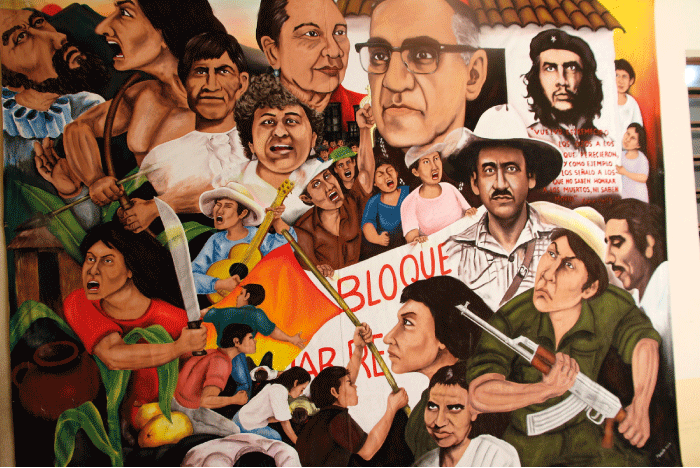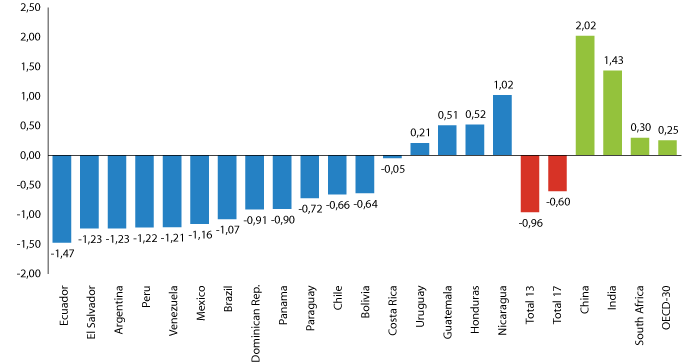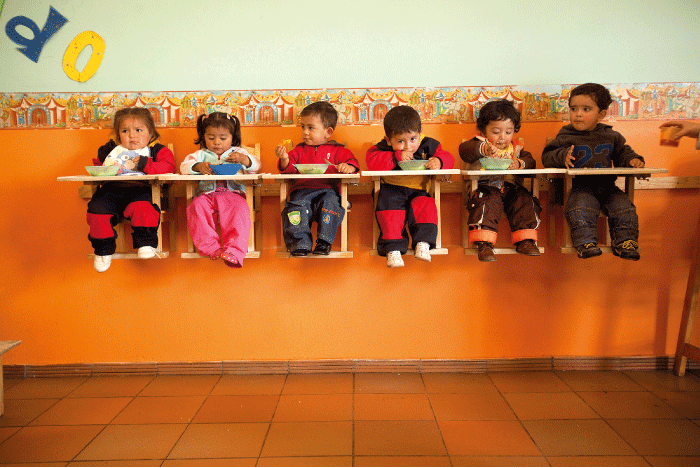2 International discourse and lessons learned
The international development debate is subject to changing emphases. In the 1990s and the early years of the new millennium, focus on the social sectors dominated. Since then, the belief that economic growth will gradually lift the masses out of poverty, an idea that was also widespread during the infancy of development aid in the 1950s and 1960s, has become more prominent. In recent years, the terms “equity” and “equality” have climbed higher up the agenda – in recognition that fair distribution will not come about on its own. The current debate is increasingly characterised by an understanding that social development must strike a balance between access to social services, sustainable economic growth and fair distribution. The Nordic model is seen by many as a role model for such balanced development. The model combines a dynamic private sector with a labour market characterised by a high degree of equality and social protection. It has evolved through a historical process of conflict and cooperation, and cannot necessarily be transferred to other countries. Each country must find its own solutions, and for some, the Nordic model can serve as useful inspiration.
2.1 From pro-poor to inclusive growth
The publication that really put the concept of equality on the global agenda was the World Bank’s World Development Report for 2006, Equity and Development. It defined “equity” as equality of opportunity and avoidance of deprivation in outcomes, without defining clear limits.
The report concluded that there is not necessarily a contradiction between policies to promote growth and policies to promote equity, as the World Bank and many others had previously assumed. The experience of the Nordic countries, where greater equality has bolstered rather than impeded long-term economic growth, contributed to this acknowledgement.
The change in the World Bank’s approach to distribution has been ground-breaking in the international development policy context, not least in relation to the World Bank’s own policy.
The report recognised that equity is about fairness, and that many people consider this to be a goal in itself. The main goal, however, was to show how equitable access to social and political opportunities contributes to economic growth and development.
The connection between equity and prosperity was explained with reference to two processes in particular. Firstly, inequalities in power and wealth will translate into unequal opportunities as long as the capital, land and labour markets do not function perfectly. Secondly, inequitable distribution of political and economic power leads to institutions that serve the elite and reinforce inequalities. Both these processes result in poor utilisation of resources and society’s productive potential.
The connection between unequal distribution of wealth, opportunity and political power results in a self-reinforcing process. Financial, political, social and cultural inequality is reinforced and reproduced over time and across generations. This results in poverty traps that are difficult to escape.
Income was primarily discussed in relation to its effect on opportunities. The report refers to income inequality as being important with respect to creating incentives to invest in education and physical capital, working and taking risk, and that, in the short term, there may be trade-offs between equity and efficiency. At the same time, however, short-term efficiency considerations can be given too much weight in relation to the long-term benefits of a more equitable society.
“Equity” has become a widespread term internationally. Few disagree as long as we are talking about equal opportunities and protection from extreme deprivation, without further specifying these concepts. The controversy partly concerns what is meant by “equal opportunities”, and partly whether large income disparities are viewed as negative in their own right.
Textbox 2.1 The Spirit Level
Richard G. Wilkinson and Kate Pickett’s book The Spirit Level from 2009 moved from the issue of equal opportunities to examining the significance of a more equal distribution of income. Using statistics from a range of countries, they show that there is a correlation between internal income disparities in a country and life expectancy, health and social conditions. They found no corresponding correlation with GNI per capita. This means that the population of countries with a higher average income do not necessarily have a higher life expectancy or better health than the population of countries with a lower average income, but that countries with greater income disparities consistently have lower life expectancies and poorer health situations than countries with less income disparity.
The Spirit Level has been criticised, among other things, for selective use of statistics, for focusing exclusively on inequality in terms of income and for leaving some countries out of the analyses. The book has nevertheless contributed to sparking debate on inequality within countries.
The 2006 World Development Report did not address income disparities to a sufficient extent. There is no contradiction between discussing equal opportunities and more equal income distribution. However, those who focus exclusively on equality of opportunity run the risk of underestimating the negative impact of high income disparities on quality of life and opportunities.
It must pay off for people to work, invest and take risks. At the same time, the Government believes that most countries would benefit from reducing inequality, both in income and in opportunities in general. Good safety nets and less income inequality increase labour market mobility and decrease the stress caused by restructuring processes by decreasing the risk and the severity of the consequences.
Increasing inequality has also been a matter for discussion in the OECD for several years. The organisation has carried out studies of social cohesion in emerging economies that show that economic growth does not automatically result in better living conditions for the majority of the population. If the trend towards increasing inequality is to be reversed, targeted policies will have to be pursued.
On this basis, the OECD and developing countries have cooperated on the creation of an analytical tool for redistributive policy. The goal is to help developing countries to identify gaps between national redistribution goals and the country’s policies. The policy areas analysed are taxation, the labour market, education and training, political participation and social safety nets. Particular emphasis is placed on geographical, ethnic and gender-related inequalities, and how they affect social cohesion. Necessary changes are discussed on the basis of the analyses.
The term pro-poor growth was introduced at around the same time as equity became a main topic in the development debate. The goal was that economic growth should benefit the poor to a greater extent. Particular focus was placed on measures aimed at creating jobs and promoting economic growth among poorer segments of the population, and on linking up poor areas with economic growth areas, among other things through infrastructure development.
Pro-poor growth has now largely been replaced by the term inclusive growth, cf. Chapter 7.1. Inclusive growth emphasises that new jobs are not usually created by the poorest people, and that reducing extreme poverty is not the only goal. The aim is also to create a growth dynamic that improves the standard of living of those who have only recently emerged from extreme poverty and make them less vulnerable.
Inclusive growth is primarily about creating jobs. Employment in low-paying parts of the production chain provides opportunities to escape from extreme poverty. This group will remain vulnerable to economic downturns and crises. Many of those who have emerged from extreme poverty live just above the poverty line of USD 1.25, with an income of less than USD 2 a day. Therefore, transfers and public services will both be necessary elements in an inclusive growth strategy.
The Government’s development policy emphasises that economic growth must be sustainable and within environmental limits. Otherwise, growth will undermine the natural basis for future growth and prosperity through the depletion of natural resources, pollution, greenhouse gas emissions and loss of biodiversity. The Government also emphasises that growth is not economically sustainable unless it also contributes to increased social equality.
The OECD and the United Nations Environment Programme (UNEP) have played an important role in the efforts to promote a “green economy” and “green growth”. These terms are used to ensure that environmental considerations are also addressed when discussing growth. In the process leading up to the United Nations Conference on Sustainable Development in Rio de Janeiro in 2012 (Rio+20), the term “green and inclusive growth” was also highlighted by several parties in order to emphasise the importance of the social dimension of a green economy and green growth. These terms describe practical strategies or approaches to achieving sustainable development in all three of its dimensions: economic, social and environmental sustainability.
2.2 After the Millennium Development Goals – new goals for old and new challenges
The time frame for achievement of the Millennium Development Goals (MDGs), which have served as a guideline for international development policy in the past decade, expires in 2015. Like other countries, Norway will emphasise achieving the goals within the deadline.
MDG 1 states that the proportion of the world’s population living in extreme poverty and suffering from hunger is to be halved. Even if this goal is reached, the fight against poverty will be far from over. The changes are based on percentages, and there will still be several hundred million people living in extreme poverty if the goal is reached. Many countries will find it difficult to achieve several of the MDGs, and some countries, particularly fragile states, will not achieve any of them. Much work remains to be done.
The UN has therefore initiated an extensive process to define a new set of goals for the period after the expiry of the current MDGs, known as the Post-2015 Development Agenda. The new goals are expected to be adopted at the UN high-level meeting in 2015.

Figure 2.1 A global partnership for development will still be needed after 2015.
Photo: UN Photo/Eskinder Debebe.
There is broad international agreement that the new goals must encompass the great changes the world has seen in the past decade. The growth seen in many traditional developing countries, together with the economic crisis in many traditional donor countries, will be highly significant. Many countries, including Norway, claim that countries’ ability to mobilise national resources through different forms of taxation and other domestic redistributive policies must be incorporated into the new goals. Aid shall and will continue to be an important source of funding for development, but it must be complemented by policies aimed at strengthening the authorities’ ability to ensure the welfare of their own citizens.
Norway is co-chair of the international consultation process on new goals in the energy sector. The Government will also work to ensure that the distribution aspect, as well as the gender perspective, are fully integrated in the new agenda.
The outcome document from Rio+20 states that an intergovernmental process will be launched with a view to developing a set of universal Sustainable Development Goals (SDGs). An open working group has been established, which will submit its report by September 2014. Norway shares a seat in this group with Ireland and Denmark.
Many view the sustainability discussion as only being related to the environmental aspect, but the sustainability concept entails a policy that integrates economic, social and environmental considerations. Most of the current MDGs deal with social dimensions, while little account is taken of the environmental aspect. It is important to the Government that the new SDGs integrate all three dimensions of the sustainability concept. Topics such as sustainable access to energy for all and improved food security must be important elements in the goals.
Two processes are taking place simultaneously to develop the new goals. The ambition is to end up with one set of post-2015 goals, and the two processes must therefore be merged well before 2015.
2.3 The Nordic model

Figure 2.2 Women's entry into the labour market has played an important role in the development of the Norwegian welfare system.
Photo: Arbeiderbevegelsens arkiv og bibliotek.
The Nordic model has become a well-known concept internationally.1 There is great interest in the Nordic experience of a well-functioning labour market and a highly developed welfare state in many developing countries. This does not necessarily mean that other countries can import the Nordic model in whole or in part, nor is it obvious that they should even try to do so. Nevertheless, countries can use it as a source of inspiration, and it is therefore important to understand how and why the model evolved. The model is the product of political conflict as well as cooperation, and the result of many choices made on a long historical road stretching from the interwar years to the present.
Textbox 2.2 The emergence of centralised wage negotiations in Norway
Some important characteristics of the Nordic model were the result of more intense competition in the world economy in the 1930s. Trade unions in industries exposed to competition had to accept substantial wage cuts for their members because of the economic crisis. They wanted to prevent wage increases in other, more sheltered sectors, as this would increase everyone’s living expenses and could also increase costs in the export industries, thereby posing a further threat to jobs in those industries. How could an increase in public expenditure in order to stimulate the economy be prevented from resulting in higher wages for people with secure jobs instead of in increased employment?
The solution to this problem took the form of a coherent approach based on centralised wage negotiations. The foundations were laid during the 1930s, and the strategy was institutionalised in the term “solidarity wage bargaining” in the 1950s. This resulted in a dramatically compressed wage structure. Although an egalitarian wage distribution fits well with the socialist legacy of the Scandinavian trade unions, the arguments put forward in favour of solidarity wage bargaining were based on efficiency considerations rather than equality. As early as in the 1950s, economists argued that greater wage equality through solidarity wage bargaining would lead to a positive development by increasing wages in enterprises and industries with low productivity while limiting wage growth in enterprises and industries with high productivity.
Although there are variations between the Nordic countries, overall, the Nordic model can be said to be characterised by the extensive use of collective solutions, a good social safety net and equitable income distribution. Experience from the Nordic countries show that a model of this kind is consistent with low unemployment and high restructuring capacity. Centralised national trade unions and employer organisations, coordinated wage formation and income policy cooperation are all important features of the model, cf. Box 2.2
Textbox 2.3 Mozambique: Great interest in the Nordic model
Mozambique is in a position to substantially increase its income in the years ahead. Recently, some of the largest gas deposits in the world were discovered off the coast of the country. Moreover, Mozambique is stepping up its extraction of coal and other minerals. But how can it be ensured that these revenues are used for the good of the whole population, and do not disappear out of the country or just benefit the elite
In order to answer this question, the Nordic embassies in Maputo organised a conference in 2012 on inclusive growth and experience of such growth in Denmark, Finland, Iceland, Sweden and Norway. The conference’s recommendations were clear: the key is to ensure transparency in the management of natural resources, strengthen the role of parliament, establish genuine social dialogue, invest in education and training, and facilitate fair distribution of public goods. Norway’s experience of social development over more than 40 years of oil extraction attracted particular interest among the more than 300 delegates.
Relatively extensive research has been conducted in recent years to determine what mechanisms can help to explain the success of the Nordic model.2 It has been pointed out that solidarity bargaining reduces wage differentials. The same is true of moderate wage settlements and a political commitment to maintain full employment and offer full insurance through universal welfare schemes for all citizens, not just the worst off.
Research on the good economic results produced by the Nordic model often describes the way in which society is organised as a state of equilibrium in which the institutions and policy formation are mutually reinforcing. The relatively small wage differentials increase political support for universal welfare schemes. At the same time, the welfare state strengthens the bargaining positions of weak groups in the labour market, and defines an implicit lower limit on wages. Low unemployment is important in order to achieve broad participation in the funding of an extensive welfare state and to keep expenditure on unemployment benefits low. An extensive welfare state makes it easier to achieve the job mobility required to maintain close to full employment. It is a fundamental principle to ensure security and stable living conditions without this being at the expense of flexibility and restructuring capacity.
One of the key elements in the Nordic model is the tripartite cooperation between representatives of the employers, the employees and the State. This cooperation covers not only wages, but also capacity-building measures, welfare goods and working conditions in the broadest sense. Collective bargaining and tripartite cooperation have gradually built trust and respect between the parties, as well as acceptance of the fact that compromises are necessary.
Textbox 2.4 China is taking increasing inequality seriously
China’s economic miracle in the past three decades has also had a dark side, namely the large and growing disparities in income and standard of living. The Chinese authorities have therefore shifted their focus away from pure economic growth towards a more sustainable growth rate with the emphasis on distribution and more social equality. This is reflected in the authorities’ five-year plans and follow-up policies, in which distribution between urban and rural areas and redistribution between China’s underdeveloped western regions and the wealthy coastal regions in the east are at the top of the agenda. Frequent mass protests as a result of social inequality and increasing dissatisfaction confirm that the authorities are under pressure to translate their policies into concrete results.
In their work on developing their welfare and distributive policies, the Chinese authorities have shown an interest in other countries’ models and experience, and various Norwegian and Chinese partners have communicated and cooperated for several years. China has been particularly interested in Norway’s experience of regional development, the development of public welfare goods, tripartite cooperation and Norway’s expertise in combining a market economy with social policy.
It has been pointed out that the compressed wage structure results in low-earning enterprises going out of business, while high-earning enterprises grow stronger. In decentralised collective bargaining systems, wages vary with enterprises’ productivity. Coordinated wage bargaining prevents enterprises with low productivity from setting low wages and thereby forces them to reduce the number of employees. At the same time, employees in highly productive enterprises and industries are prevented from taking a share of the proceeds of high productivity in the form of higher wages. This steers labour and capital away from enterprises with low productivity and towards highly productive enterprises. This improves efficiency and production overall, and reduces wage differentials.
The other key element of the Nordic model is a welfare state based on universal benefits. The welfare schemes were developed through political decisions over a long period of time as the result, among other things, of strikes and conflicts. The system comprises many schemes that are intended to prevent people from falling below a minimum material standard of living.
Equal opportunity is promoted by means of substantial public investments in subsidised day care centres for children, a good-quality, free public education system and a system for financing higher education.
The Nordic countries have taken deliberate steps to promote gender equality, and have achieved a high degree of equality compared with most other countries. Women’s labour market participation has been of great economic importance. This is partly the result of child care and housework having gone from being unpaid work outside the national economy to becoming part of the gross national income, but it is primarily because the potential of women has been unlocked. Giving everyone equal opportunities results in an efficiency gain because more people work and pay taxes, and because tasks are carried out by the best qualified people, regardless of gender, age, family situation or social status.
To sum up, the Nordic model is the product of our society, the historical context, political choices and political conflicts. The fact that the Nordic countries are relatively small and homogeneous has contributed positively to the development of the Nordic model. The Nordic countries have not been dominated by extreme and changing ideologies, but have instead moved towards a relatively stable balance between public and private engagement.
The challenges facing developing countries in connection with the introduction of systems that ensure a small wage differentials and good social insurance are not merely of an economic nature – there are political and institutional challenges as well. It is not a given that the leaders of the different countries are interested in introducing such systems. Where there is an interest, however, the Nordic model can serve as inspiration for these countries to negotiate their own solutions.
In Norway’s case, it was the economic crisis in the 1930s that triggered increased cooperation and collective solutions. Political leaders in developing countries can make use of the freedom of manoeuvre that arises, for example in a crisis, to see new possibilities and promote change. It is more difficult to agree on collective solutions in big countries with great inequality and conflicting interests than it is in relatively small and homogeneous countries.
The Government will establish a network of relevant actors from the public sector, the social partners, academia and civil society. This network’s expertise will be available to countries that are interested in learning more about the Norwegian experience of welfare and distribution policy.
2.4 Experience from countries that have succeeded in reversing great inequality

Figure 2.3 Social change does not come about without a struggle. The mural gives a glimpse of Latin America’s history.
Photo: Ministry of Foreign Affairs/Svein Bæra.
Latin America is the continent with the greatest inequality. The roots of this inequality go back to colonial times and are related to the inequitable distribution of land and to structures that have maintained the social and economic exclusion of large sections of the population together with extremely low levels of social mobility. At the same time, it is also the only continent that has seen a reduction in inequality in a majority of countries during the past decade. It may be natural for a continent with such a poor starting point to show particularly visible progress, but there is no doubt that the reduction in inequality has come as the result of a deliberate policy whereby substantial resources have been invested in achieving change. This is an important reason why China is also taking inspiration from measures implemented in Latin American countries to achieve more fair distribution. Experience from the Latin American countries, among others, could be of interest to more developing countries. The Government will finance South-South cooperation on the exchange of experience of distribution and welfare policies.

Figure 2.4 Average percentage annual change in the Gini coefficient in Latin America compared with a selection of other countries, 2000–2010. Negative figures mean that inequality has decreased.
Source Source: Declining Inequality in Latin America in the 2000s: The cases of Argentina, Brazil and Mexico. Lustig, López-Calva and Ortiz-Juarez, World Development (2012).
Reduced inequality in a society is the result of many factors. It is therefore difficult to describe the effect of one particular policy or measure. However, there are some general features of developments in Latin America in recent years that appear to be highly relevant. Several years of economic growth have contributed to increased demand for labour, including unskilled labour. At the same time, there has been a strong and systematic focus on education, with improved primary school coverage for poor groups. Illiteracy has been reduced, and the number of skilled workers has increased. The result is a general increase in employment in the formal sector, a key factor in the reduction of inequality.
These factors do not explain all of the progress made, however. Extensive and progressive transfers of government funds to marginalised groups have been an important supplement in an otherwise favourable macroeconomic situation. Conditional cash transfers are one measure that has often been emphasised in this context. The first programme of this kind was introduced in Mexico, and similar programmes have since been introduced in countries such as Argentina, Brazil, Chile, Peru, Venezuela, Bolivia and Ecuador. The social programme Bolsa Familia (family grant) is the best-known example, see Box 6.3 for a description.
A study of the income situation in Argentina, Brazil, Peru and Mexico over the past decade points out that, in addition to cash transfers, the reduction in the wage differential between skilled and unskilled labour has been an important factor in reducing inequality. This reduction is in turn the result of measures such as an increased minimum wage, targeted investments in primary school education and subsidies paid to poor families to send their children to school. For the measures to be effective, in other words, a coherent policy, in which the different components underpin each other, is necessary. A political agenda and clear priorities that are communicated externally are also important preconditions for success.
Political ownership of these measures is the result of demand among voters for a policy for more equality and poverty reduction. Several governments have been re-elected on such programmes. Part of the reason for this stems from the 1980s and 1990s, when the financial institutions demanded restructuring of the economy, which resulted in privatisation and liberalisation. Poverty grew despite economic growth in the 1990s, and the trickle-down effect failed to materialise.
The progress towards reduced inequality in Latin America will not continue by itself, but will require continued focus and an explicit political will. Democracy and human rights must be further strengthened. Strong regulation and a redistributive policy have been crucial in the countries that have succeeded in reversing the trend. Not all Latin American countries have seen such progress, however. In some countries, regulation has often been too expansive while growth has been weak. It is also important, therefore, to understand how distributive policies have failed to produce the desired outcomes in some Latin American countries.
Various international organisations can set the agenda and support national measures. The Economic Commission for Latin America and the Caribbean (ECLAC) is a key development actor in the region. It represents an important voice and agenda setter in relation to reducing poverty and inequality. This organisation, with its long-term perspective and political support among Latin American countries, is well placed to promote distributive policy at the regional level. ECLAC works to promote structural changes in production systems and improve labour market regulation, including collective bargaining systems, and clearer taxation policy measures. These components are also relevant to the work of other multilateral actors. Norwegian support for ECLAC, which aims to strengthen the organisation’s capacity to influence policy formation and to assist countries with policy implementation, is regarded as a strategic effort.
The Community of Latin American and Caribbean States (CELAC) was established in 2010 in order to strengthen integration between its 33 member states. CELAC works on issues relating to inequality and social development, and the Government will initiate collaboration with the organisation.

Figure 2.5 The provision of day care centres for children, as shown here from Colombia, is a precondition for women's labour market participation – which, in turn, is crucial to the development of a welfare state.
Photo: Ivan Kashinsky/Panos/Felix Features.
The Government will:
work for the integration of issues relating to fair distribution and the gender perspective into the new international agenda for post-2015 development goals, and will take particular responsibility for the integration of energy issues into this agenda
establish a Norwegian network that can share Norway’s experience of distribution and welfare policy with interested countries
finance South-South cooperation on exchange of experience of distributive and welfare policies
enter into cooperation with the Economic Commission for Latin America and the Caribbean to strengthen its capacity to assist countries in the region in their redistribution efforts
take an initiative vis-à-vis the Community of Latin American and Caribbean States on collaboration and dialogue on distribution issues.